A Narrative Photo Essay on NASCAR’s bold new race on the streets of Chicago
I never grew up watching motorsport. My only exposure to that world was watching the movie Cars an embarrassing amount of times as a child. But it wasn’t until Netflix’s docuseries Drive to Survive, which follows the dramatic world of Formula 1, that I truly fell in love with the sport. For months after watching, I was enamored, not just with Formula 1, but all disciplines of motorsport. I tried to watch everything I could from endurance racing to rallying, even IndyCar (America’s alternate version of Formula 1). There was just something inexplicable about this sport where drivers willingly strap themselves into ungodly machines designed with the simple goal of going as fast as possible; I was hooked, and I had no clue why.
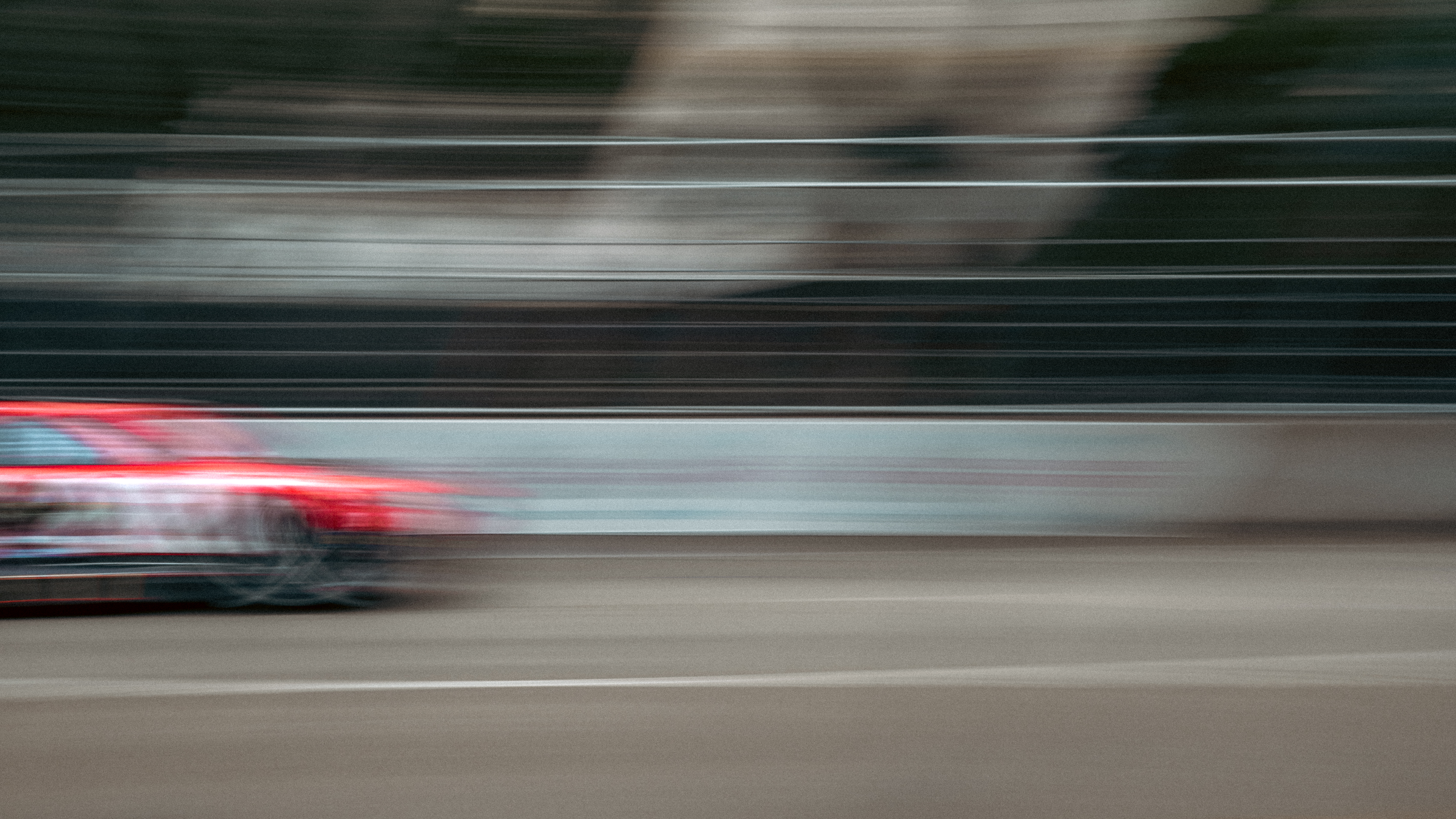
Christopher Bell, driver of the No. 20 Craftsman Racing For A Miracle Toyota, racing down South Columbus Drive during the NASCAR Cup Series Grant Park 220. Photo by Varun Khushalani.
However, there was always one exception to this newfound fascination, one discipline and brand I never had an interest in following. Something about NASCAR always turned me away, whether it was the seemingly lackluster spectacle of oval racing, the disturbingly overt patriotism, or even the overall brutality of this type of racing. I had fallen in love with the beauty of motorsport and those places in the world dedicated to pushing engineering and raw skill to the limit: taking Eau Rouge flat out at Spa-Francorchamps, gliding elegantly down the Fairmont Hairpin in Monaco, or surviving the Porsche Corners deep in the morning during the 24 Hours of Le Mans. Obviously, there is a harsh danger in every element of this sport. Circuits worldwide have claimed the lives of those intrepid enough to push them. It’s a dangerous environment. But we buy into that every time we turn on a race. We accept the consequences because we want to see the limit pushed. I think it is a net positive for humanity that Max Verstappen can set a lap record every time he steps on a track. Granted, it might not be the most enthralling entertainment, but it’s incredible to see: putting speed over safety in the name of going faster.
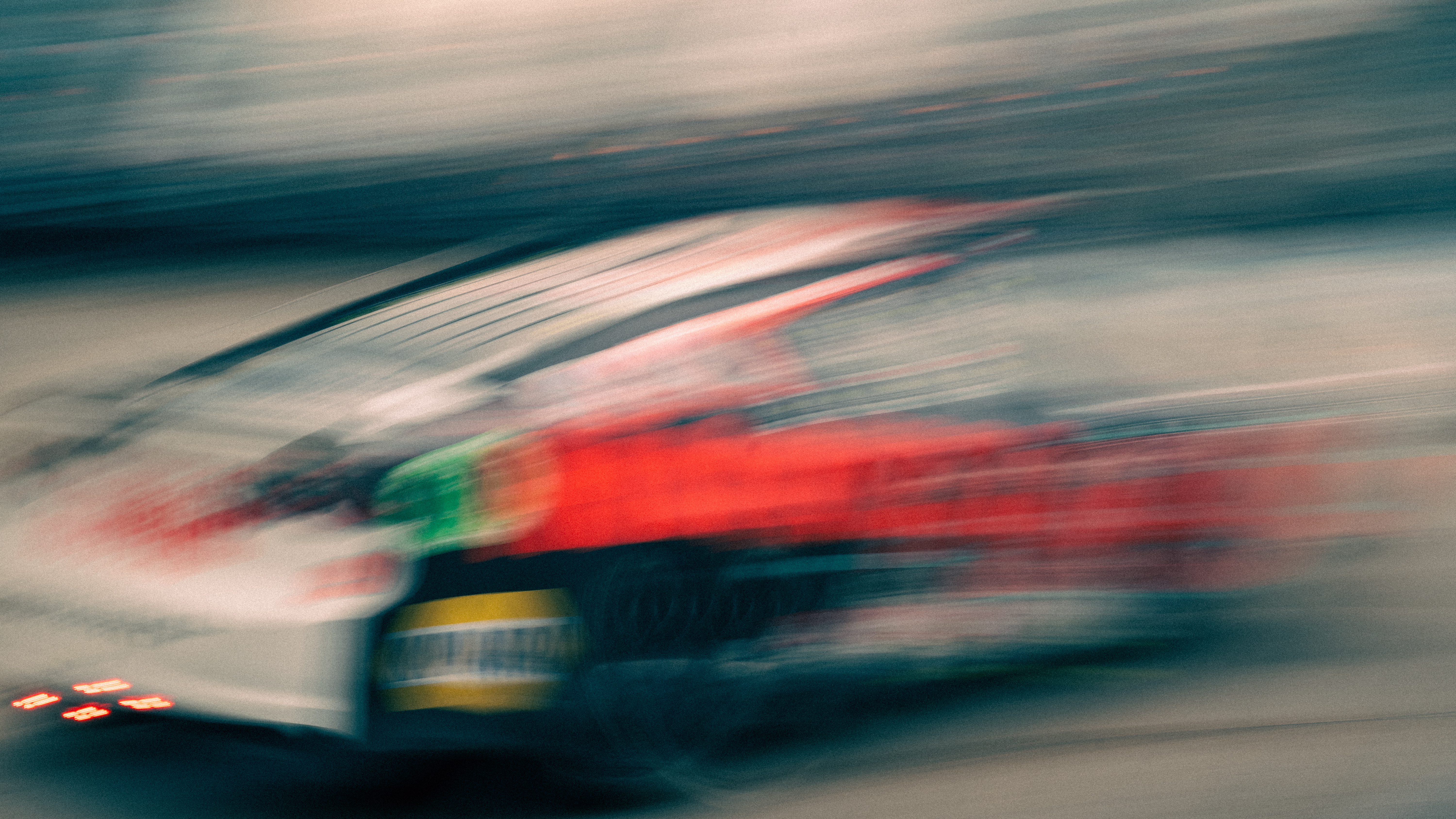
Chase Elliot, driver of the No. 10 Hooters Chevrolet, exiting Turn 5 during the NASCAR Cup Series Grant Park 220. Photo by Varun Khushalani.
For some reason, that risk never brought me to NASCAR. When the brash nature of the sport becomes one of its major selling points, the beauty of the sport goes away. Maybe it is the lifetime of tennis in me, but there is something to be said about the honor and respect that comes with racing. Pushing flat out, but still with the acknowledgment that those around you are doing the same. With NASCAR, it always seemed to me that it was pushing flat out in spite of those around you. But, for all my negative opinions, I couldn’t not witness the spectacle when I learned NASCAR was coming to Chicago.
—
NASCAR is officially known as “stock-car racing,” where drivers use modified versions of standard production model cars around ovals or road courses. In the sport’s early days, there were requirements that all the parts of the cars had to be parts that the public could buy themselves. Even though the cars on track are fundamentally different from their real-world counterparts, they are designed in the image of the same cars that drive on American roads daily. Walking into the track on the Friday before the race, I was shocked to find how similar these cars looked to the suped-up speed demons that storm down Fullerton Avenue every night outside my apartment. But nothing could prepare me for the actual racing.
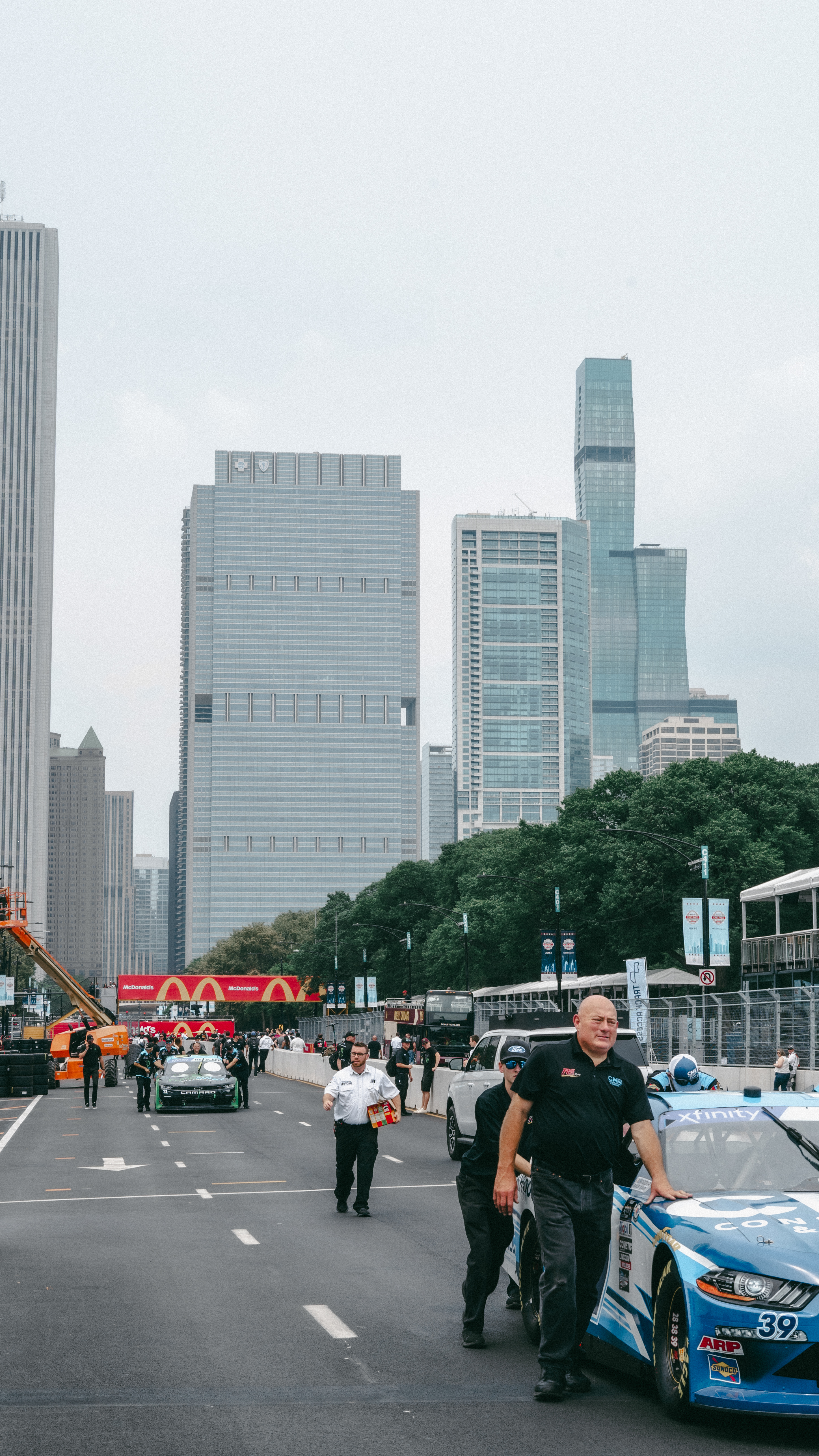
Xfinity Series teams moving their cars to pit road on South Columbus Drive. Photo by Varun Khushalani.
On Friday, I took a bus tour of the track with other journalists, photographers and certain VIPs. What made this race so special was the fact that the track that snaked through Grant Park was what’s called a “street circuit,” the first ever in NASCAR history. Instead of using a course that was designed for racing, streets from the city itself are used to create a track. These differ from road courses because the margins for error are so much smaller. The Circuit of the Americas, in Austin, where NASCAR, Formula 1, and other disciplines race, is a quintessential road course in the spread of tracks worldwide. The racing is just as fast, but the difference is the space the drivers can use. At COTA, there are gravel traps or runoff areas all alongside the track, so if a driver is pushed wide or goes too deep into a turn, they can just go off to try and rejoin the race after recovering. We all were starting to realize on this Big Bus-sponsored tour, that there was almost no space. The 2,200 concrete barriers that lined the track, each weighing approximately 10,000 pounds, created this insulating cage around the racing to prevent damage outside the track, but with the consequence of promising damage on track for the drivers if even the slightest mistake is made.
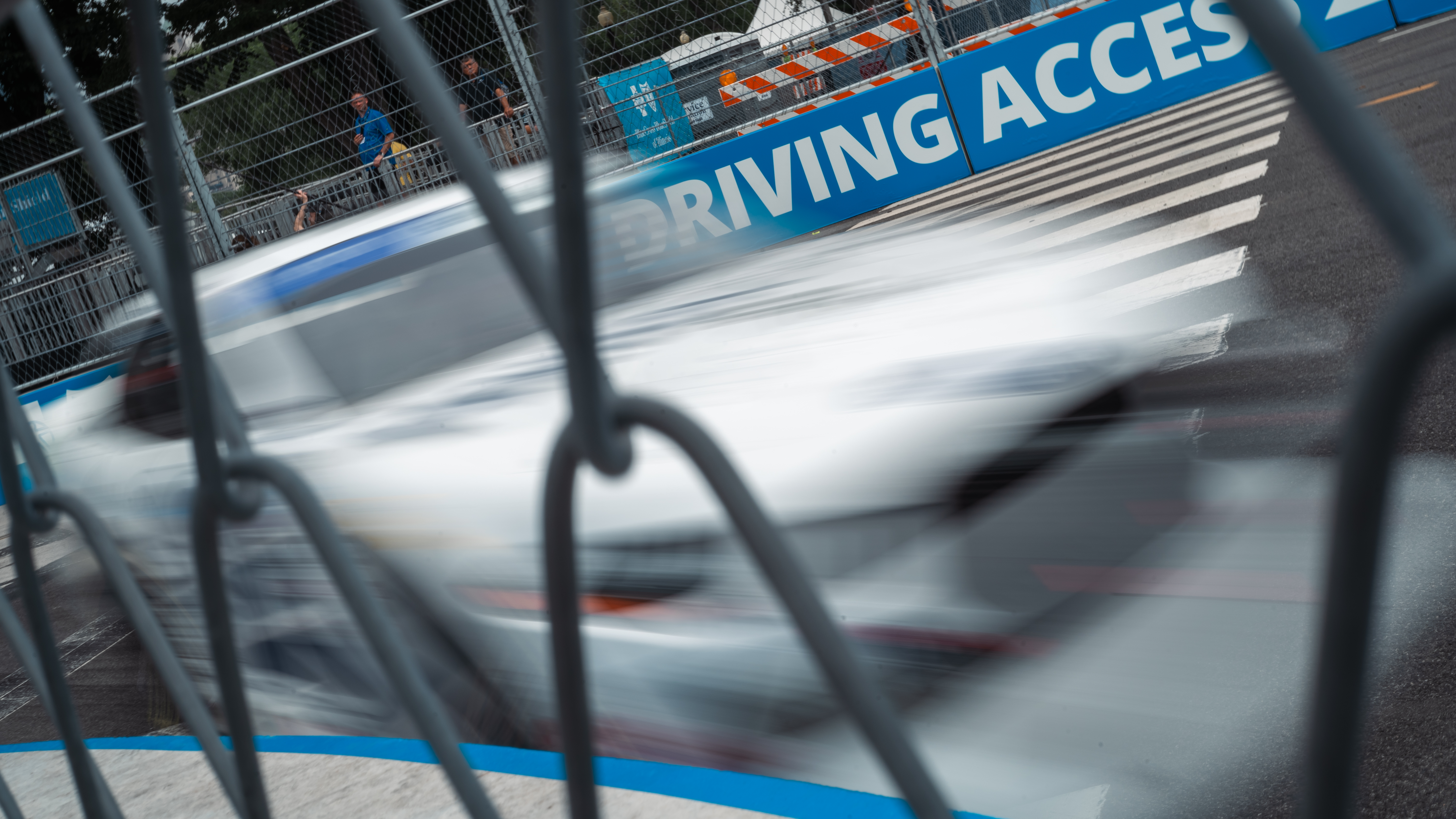
Brent Sherman, driver of the No. 28 HawkAuto.com/A. Marek Jewelry Ford, at the entrance of Turn 2 during qualifying for the NASCAR Xfinity Series The Loop 121. Photo by Varun Khushalani.
As I got to the track on Saturday, I had some expectations of what cars going around a track would be like. I thought a few years of following this sport would train me to handle the feeling of a race car in front of me. I had seen highlight after highlight of these races, watched the broadcasts live, and followed trends and social media speculation religiously in particularly boring stretches of my life. So as I sat in Turn 1, opposite pit road, I was calm, but there was this underlying burning excitement. The day’s first running was practice for the Xfinity Series at around 11, and the grandstand opposite pit road was sparsely populated. In that corner, right before the cars were fired up, this odd feeling came over me. I’ve photographed a few events before, but this was a different beast altogether. I had, just 30 minutes ago, nervously spilled coffee in a room full of incredibly expensive camera equipment, and now I was on the clock. Racing was something I had desperately wanted to see for a while now, and now it was my responsibility to photograph it professionally. In that moment, I felt quite alone.
—
You can never prepare yourself for the sound of a naturally aspirated V8 engine 20 feet away from you. It’s so unnaturally loud, like a scream. It’s one of those few sounds that makes your entire body tense when you hear it. When the cars first fire up, they do it behind a wall on the other side of the pitlane, so all you know for a split second is that sound. It doesn’t hurt (yet), but it fills every pocket of air in a wide radius. Then, after all the engines have been started, the cars line up at the end of the pit road, ready to go out. They do a quick check before the green light is given, then, one by one, they roar out onto the track, taking a sharp left turn out of the pit exit onto the course.
From that point on, everything became a blur. Maybe it was the smell of burning rubber combined with gasoline and miscellaneous oils, but full sessions went by in an instant. It’s much harder to follow the action without readouts or commentary; I only knew what was going on if I was lucky enough to be in a corner with a screen in sight. But I didn’t care about the standings or the timing charts. I wasn’t just a spectator; I was part of it.
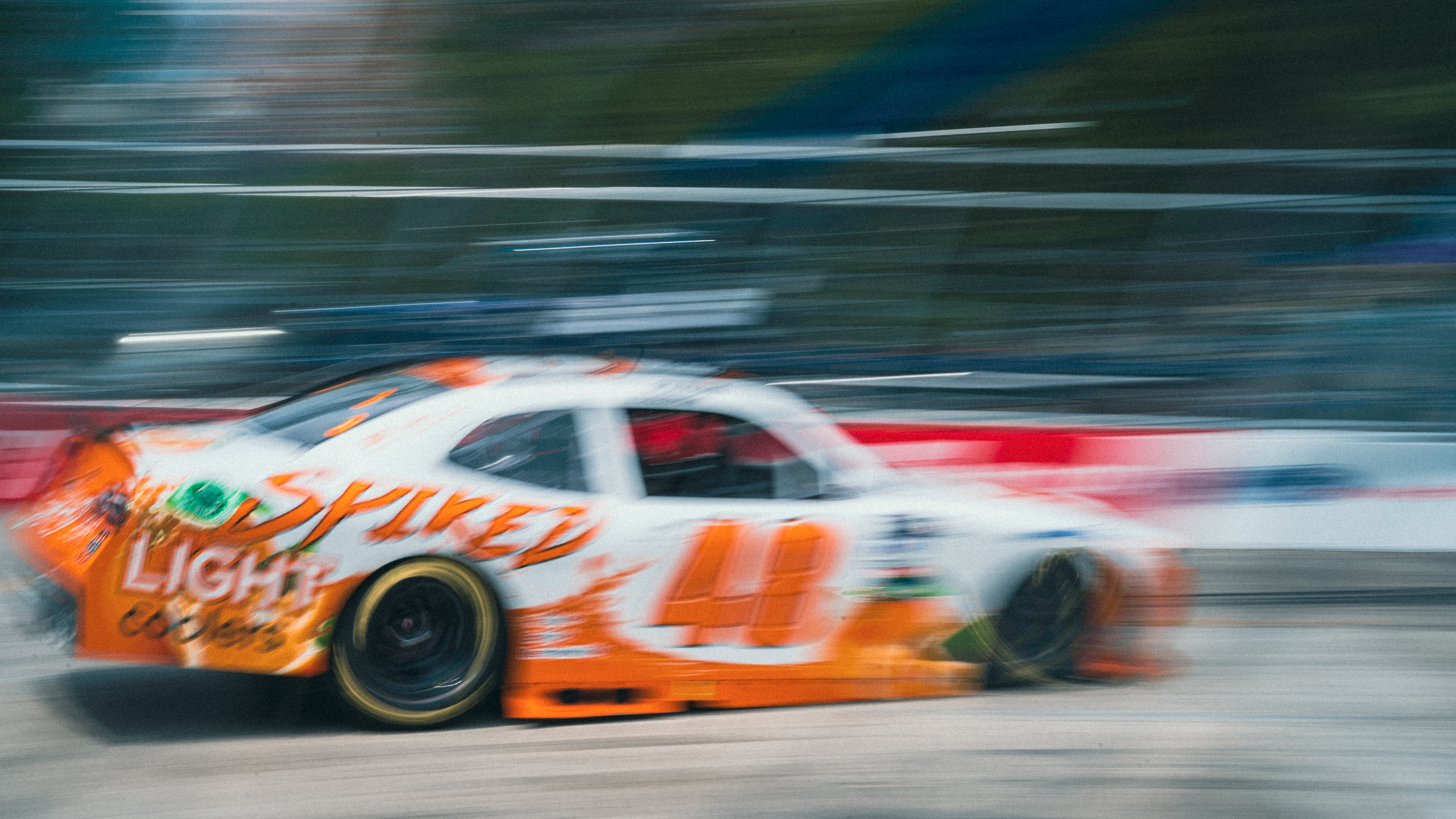
Parker Kligerman, driver of the No. 48 Spiked Light Coolers Chevrolet, at the entrance of Turn 6 during practice for the NASCAR Xfinity Series The Loop 121. Photo by Varun Khushalani.
For those who don’t know about photography in motorsport, there is a space between the barriers of the track and the fences to limit where the spectators are allowed. Photographers, safety marshalls and (for some reason) VIPs, are the only ones allowed in that buffer just beyond the track. That buffer, which on this course goes almost entirely around the track, is no joke. It’s right up against the racing, with cars at points, just inches from the spots we stood in.
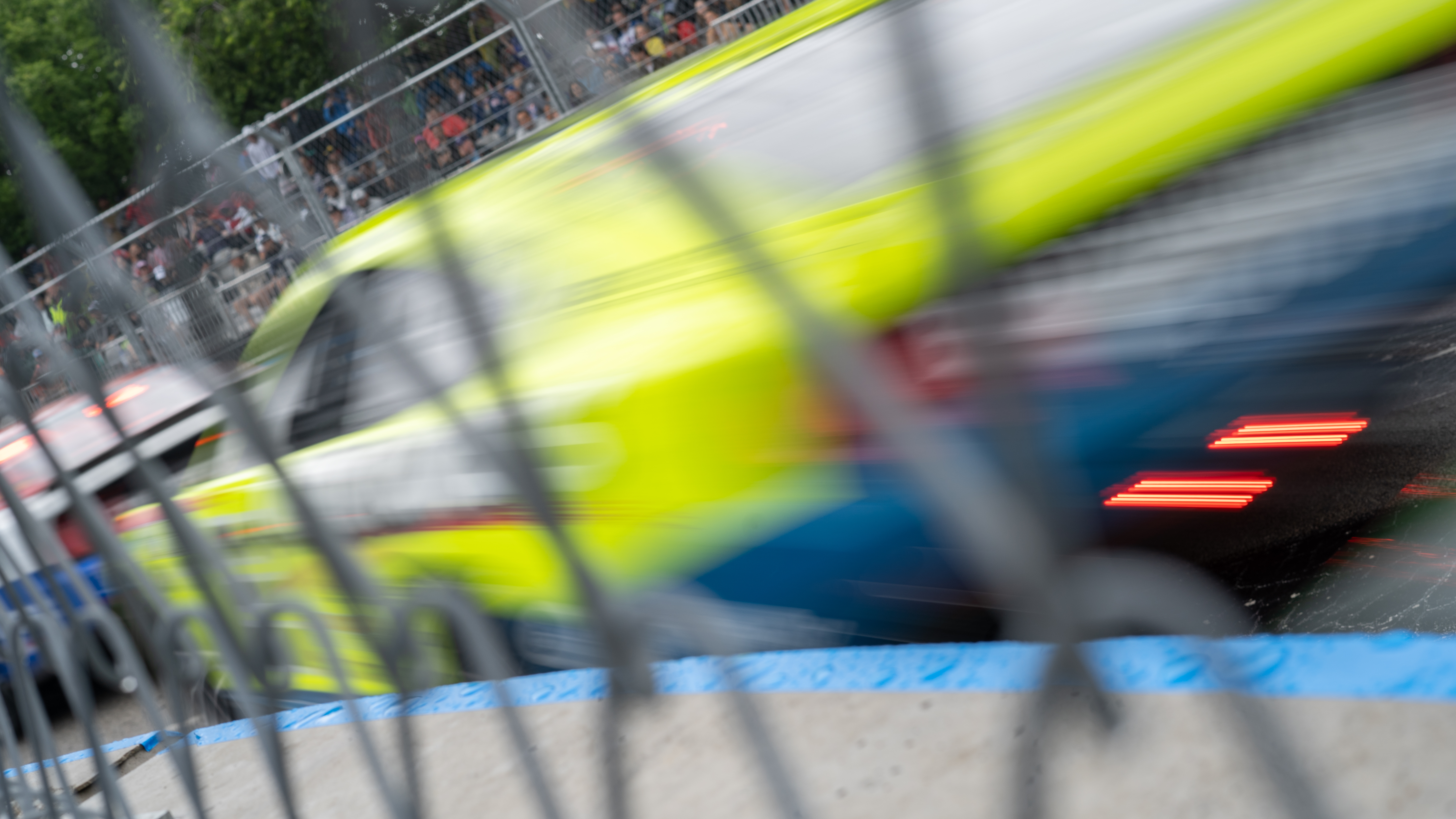
Brandon Jones, driver of the No. 9 Menards/Little Hug Chevrolet, following Ryan Preece, driver of the No. 41 Operating Engineers Ford, at the exit of Turn 1 during the NASCAR Cup Series Grant Park 220. Photo by Varun Khushalani.
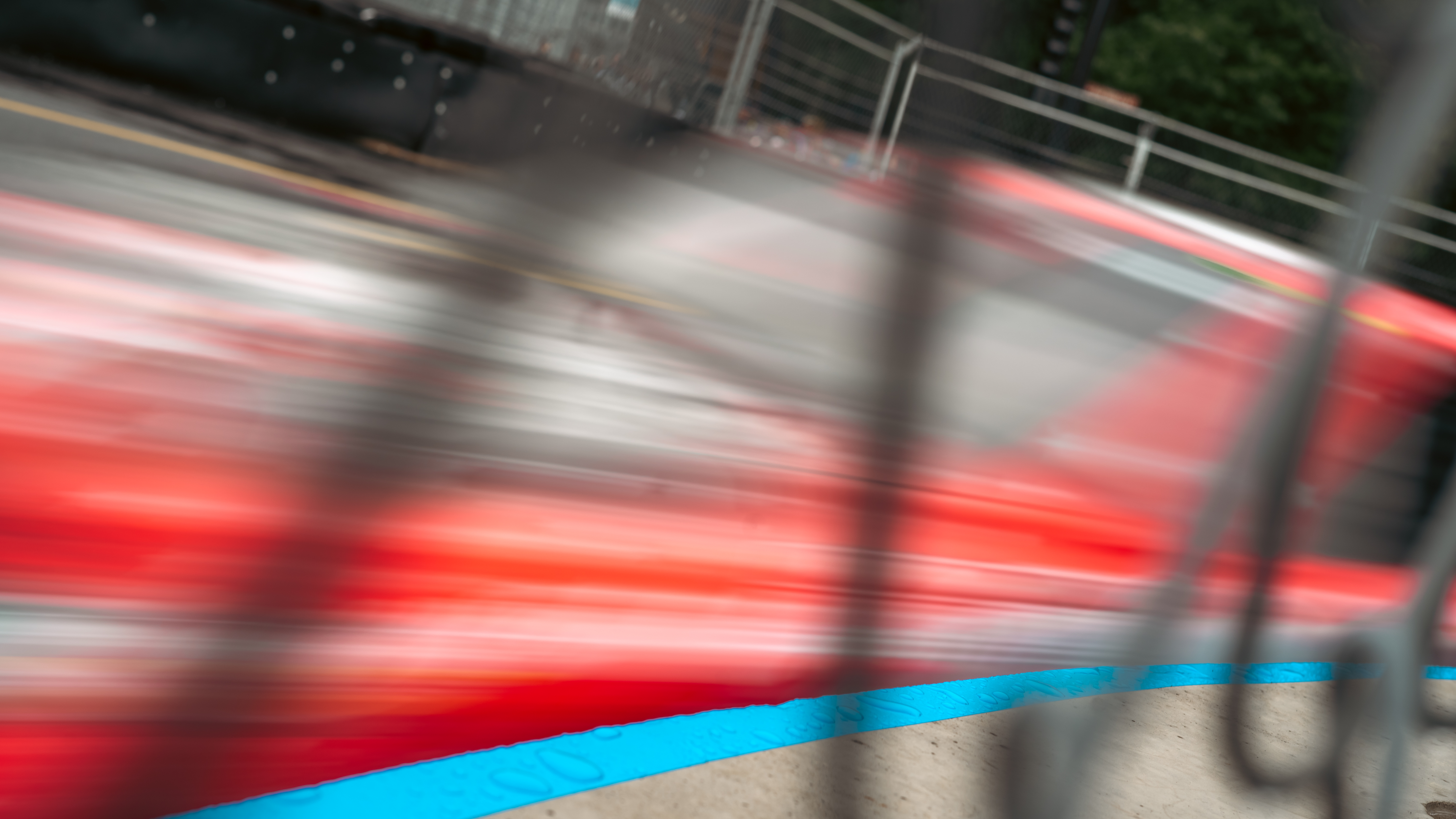
Michael McDowell, driver of the No. 34 Chicago Pneumatic Compressors Ford, at the entrance of Turn 1 during the NASCAR Cup Series Grant Park 220. Photo by Varun Khushalani.
The first couple of times you get close to the wall are terrifying. It’s alright at first; you get ready to take the shot, make sure everything is ready. But then you hear that sound, and you feel the vibration through your shoes, then your whole body. People in the grandstands begin to turn and yell and point. Then all of a sudden, the downshifts into the corner announce its arrival, and there it is. A full race car moving at speeds too fast to perceive, but only for a moment. So close you could reach out and touch it. In the slow corners they almost stand still. And then you blink. By the time you open your eyes, they’re already speeding down into the next turn. You turn around and wait to try and get the shot again. And again. Car after car. A lot of times, you don’t get the shot you want; they just move too fast. But once you think you’ve taken enough to annoy yourself with options later on, you step out of that photo hole, walk down a couple hundred meters, and try again in the next corner. And then the next. And then the next.
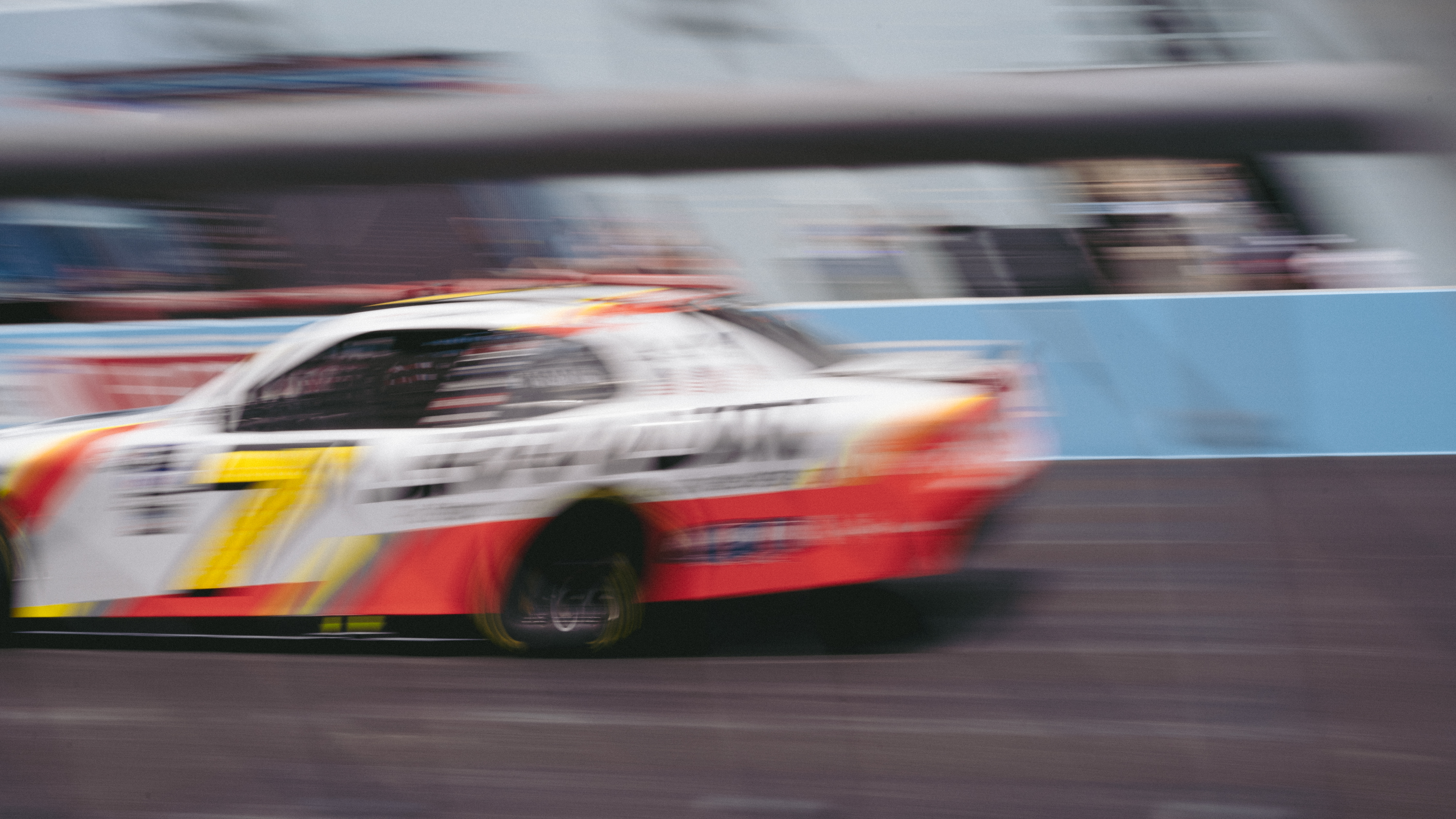
Justin Allgaier, driver of the #7 BRANDT Chevrolet, driving past the start/finish line during practice for the NASCAR Xfinity Series The Loop 121. Photo by Varun Khushalani.
By the time I reached my 10,000 steps, and then some, the time had come for the Loop 121, part of the Xfinity Series, NASCAR’s feeder series with less powerful cars designed to train up-and-coming drivers before putting them straight into the main championship, the Cup Series, which race would run the next day. I knew the important race would be on Sunday, so I took the first one to practice, to test and find the shots I wanted. As I got set up on a straight that was painted bright red in Mcdonald’s advertisements, I got ready and waited. It’s important to know that NASCAR utilizes a rolling start rather than a standing start. In a rolling start, all the cars follow a safety car in formation until the first lap, and when the safety car goes into the pits, the cars just go for it.
The noise of the cars is deafening when there’s only one. Now, multiply that by 38. You could hear from a distance, the buzz of cars ebb and flow as they took turns, advancing on the track. Right before the race began, I stood on East Jackson Boulevard, where the final turn was before the pit road and the start/finish line. The chorus of roars approached Turn 11, and I saw the safety car duck into the pits. Cole Custer in the No. 00 Stewart-Haas Racing Ford appeared in front of me as he began to lead a sea of cars into Turn 12, accelerating onto the main straight towards the start/finish line. Thirty-eight race cars driving at top speeds right next to you is a jarring experience. Try it sometime. Even just thinking about it, I still shudder from that feeling, the extreme vibrations jolting every nerve on edge, standing every hair straight up.
—
Street circuits are one of the highlights of motorsport. People from all around the world flock to the Circuits of Monaco, Marina Bay in Singapore and even Long Beach in California to witness these street races. They are notorious for being incredibly demanding and difficult for drivers, requiring the utmost skill and accuracy for hours. When one small mistake could put you in the wall at speeds unimaginable to even the riskiest of road drivers, you must be perfect under perfect conditions. And when conditions get less than ideal (like when it rains), you just have to be lucky. The cars that race in both NASCAR’s Cup and Xfinity Series are extremely heavy relative to other motorsport disciplines. There is a reason Chicago is the first street course NASCAR has ever raced on. To push cars this hard around a street circuit, they need to be able to turn nimbly and quickly, to enter and exit corners with grace and agility. These race cars weigh somewhere in the ballpark of 3,500 lbs, about the weight of a standard mid-size car. This isn’t Mario Kart. These cars have inertia, and when they make a mistake, they go into a wall, hard. When 38 of these cars are jostling for inches on track and tenths on the timing chart, they bump into each other. Driving perfectly becomes exponentially more complicated when two cars battling behind you are going into the same corner you are.
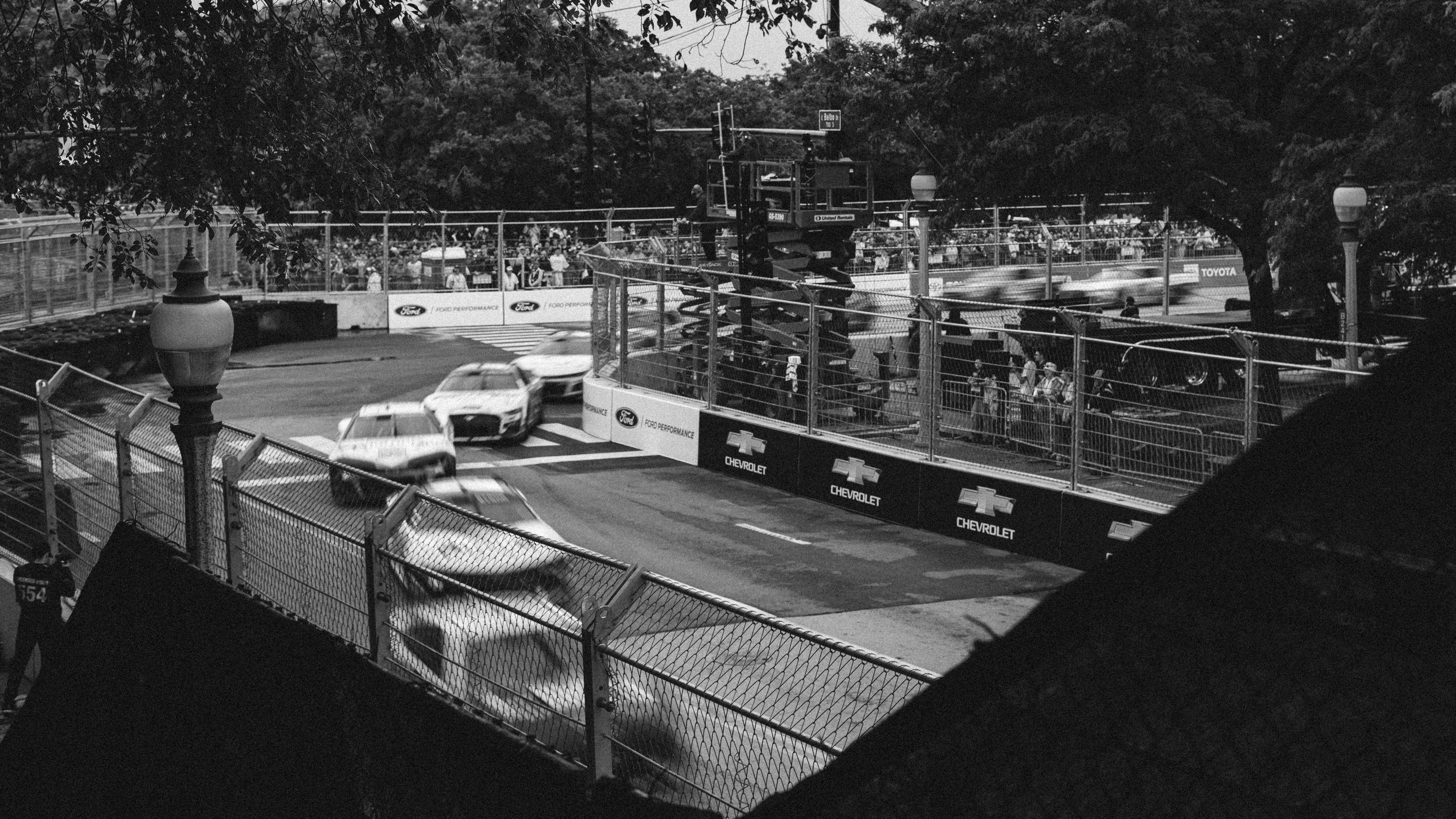
Turn 6 during the late stages of the NASCAR Cup Series Grant Park 220. Photo by Varun Khushalani.
The race, which was planned to be 55 laps, was put under caution three times within the first 25 laps, nine of those being under yellow flags, where racing is suspended. Cautions like this aren’t uncommon in motor racing, especially street circuits where drivers are under the most pressure. But the real issues began to come when the clouds got darker, and the storm that had been pestering the race track became more than just an annoyance.
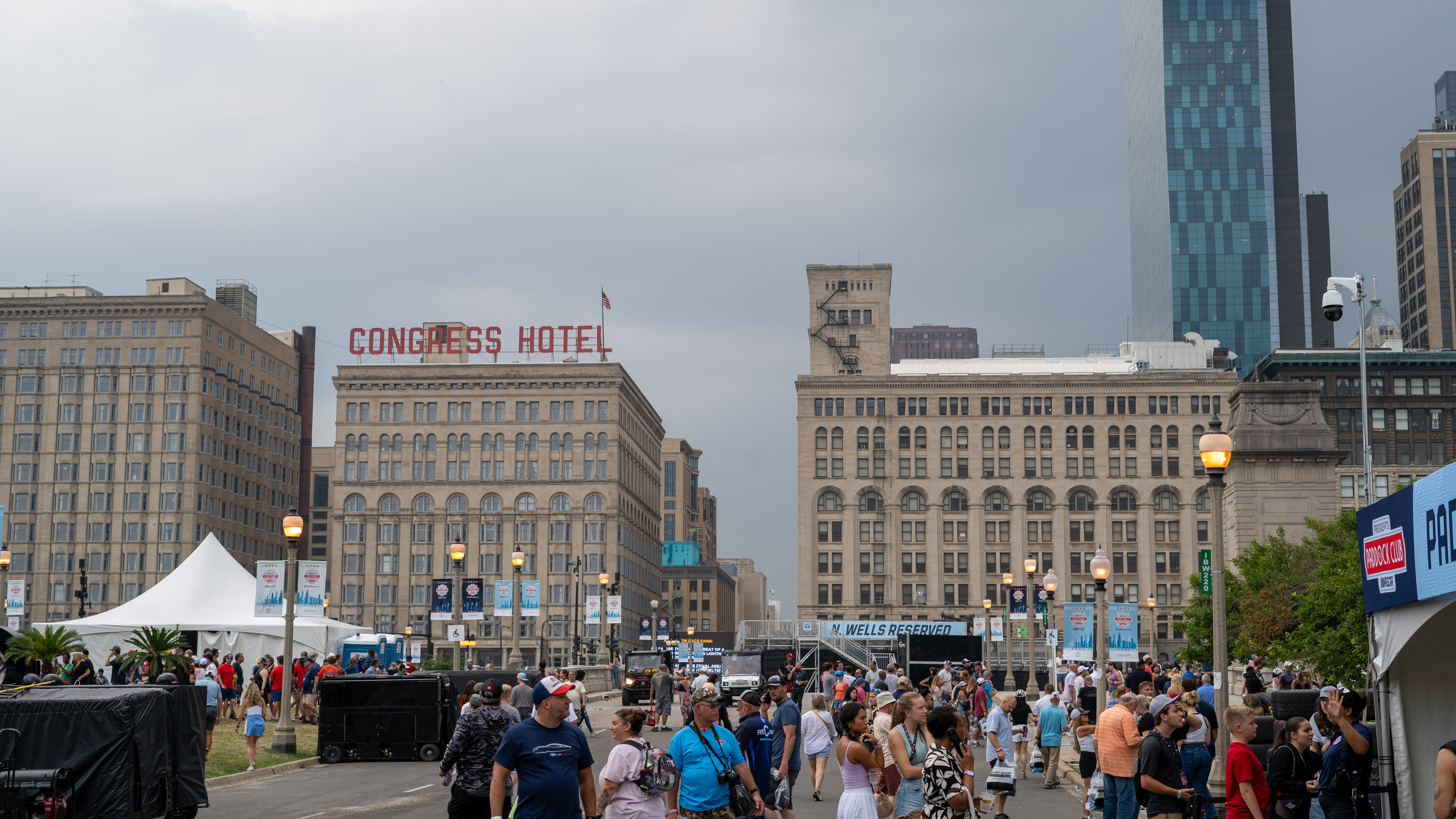
Spectators evacuating the track after lightning in the area caused officials to postpone the NASCAR Xfinity Series The Loop 121. Photo by Varun Khushalani.
It’s impossible to plan for extreme weather; I understand that. What it is possible to plan for is the possibility of extreme weather. If you look at the map of the race course, you will see it is split up into different areas, two of which are enclosed by the track and require a bridge to access. As the rain grew in intensity and the race continued under caution, the possibility of a race delay became more and more likely. So when race officials announced that everyone had to evacuate the race site due to lightning strikes in the area, there was disappointment but it wasn’t a surprise. The race officials played it by the book and played it safe because at the end of the day, the safety of fans and spectators should be the top priority. Now, this priority (apparently) did not apply to the bridge planning process because as soon as the evacuation was announced, every single spectator in the enclosed rectangle created by Turns 1/6, 7, 11 and 12 headed towards the only exit possible, over the McDonald’s bridge at Turn 12. This bridge, which created large lines and bottlenecks during normal usage, became a mass congregation of fans who wanted to go home and escape the rain. It wasn’t a pretty sight.
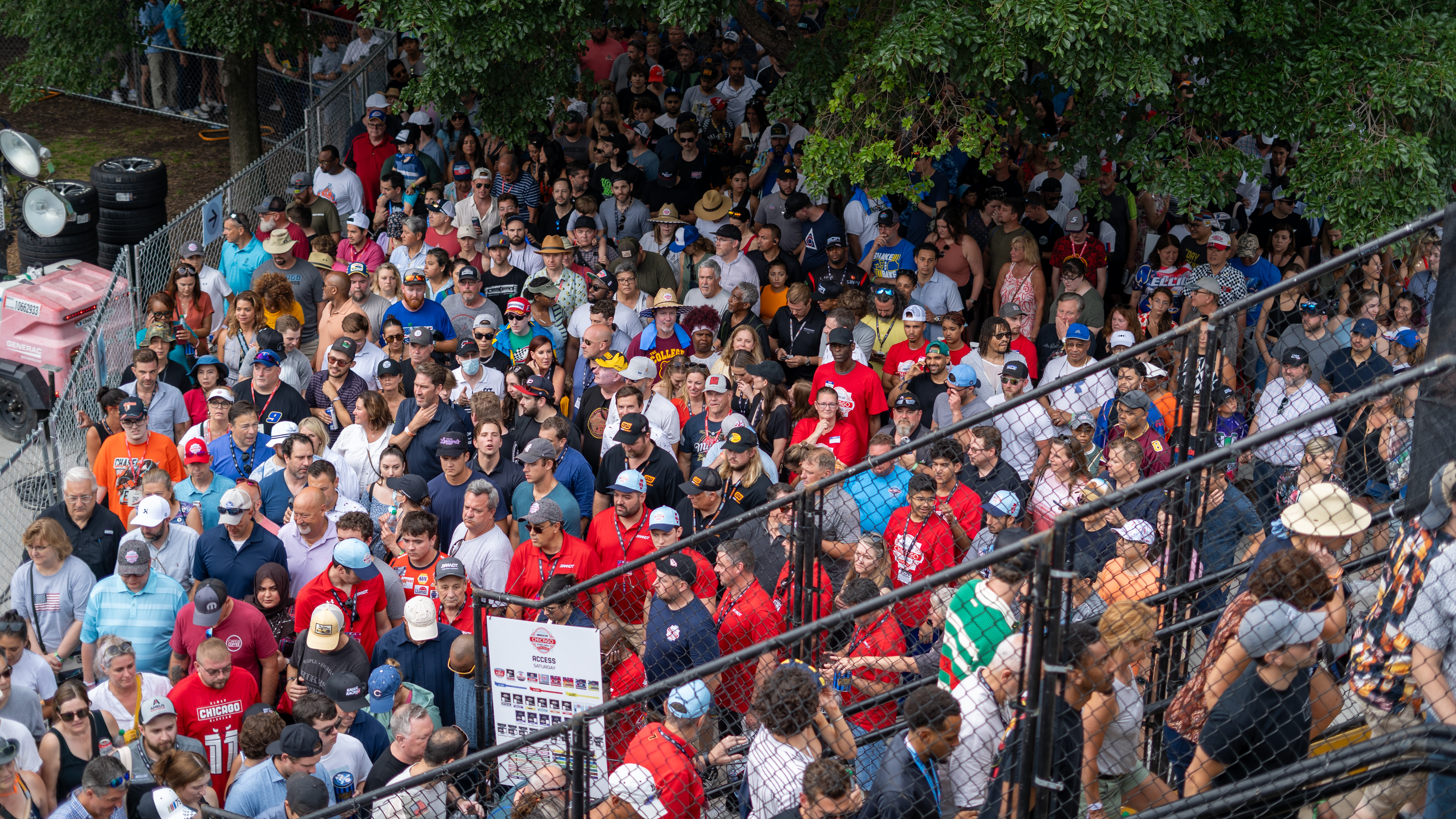
Fans attempting to leave the track through the bridge which goes over Turn 12. Photo by Varun Khushalani.
The race had been delayed to 11 a.m. the following day. Any memory of that Sunday will tell you that it rained as hard as possible much longer than 11 a.m. the following day. NASCAR had to make an unprecedented decision, calling the race for Cole Custer before they were allowed to do so under the sporting regulations. Because of the stress it would put on the city of Chicago to race again the following Monday, just to race for the two laps before, NASCAR and its officials had to alter the rules for this occasion. This decision, while delayed until the last possible moment, was the only move they could make. Even driving two laps under those conditions to reach the technical limit could have led to serious consequences if something were to go wrong. After they made the decision, NASCAR moved on to prepare for the main event, the Grant Park 200.
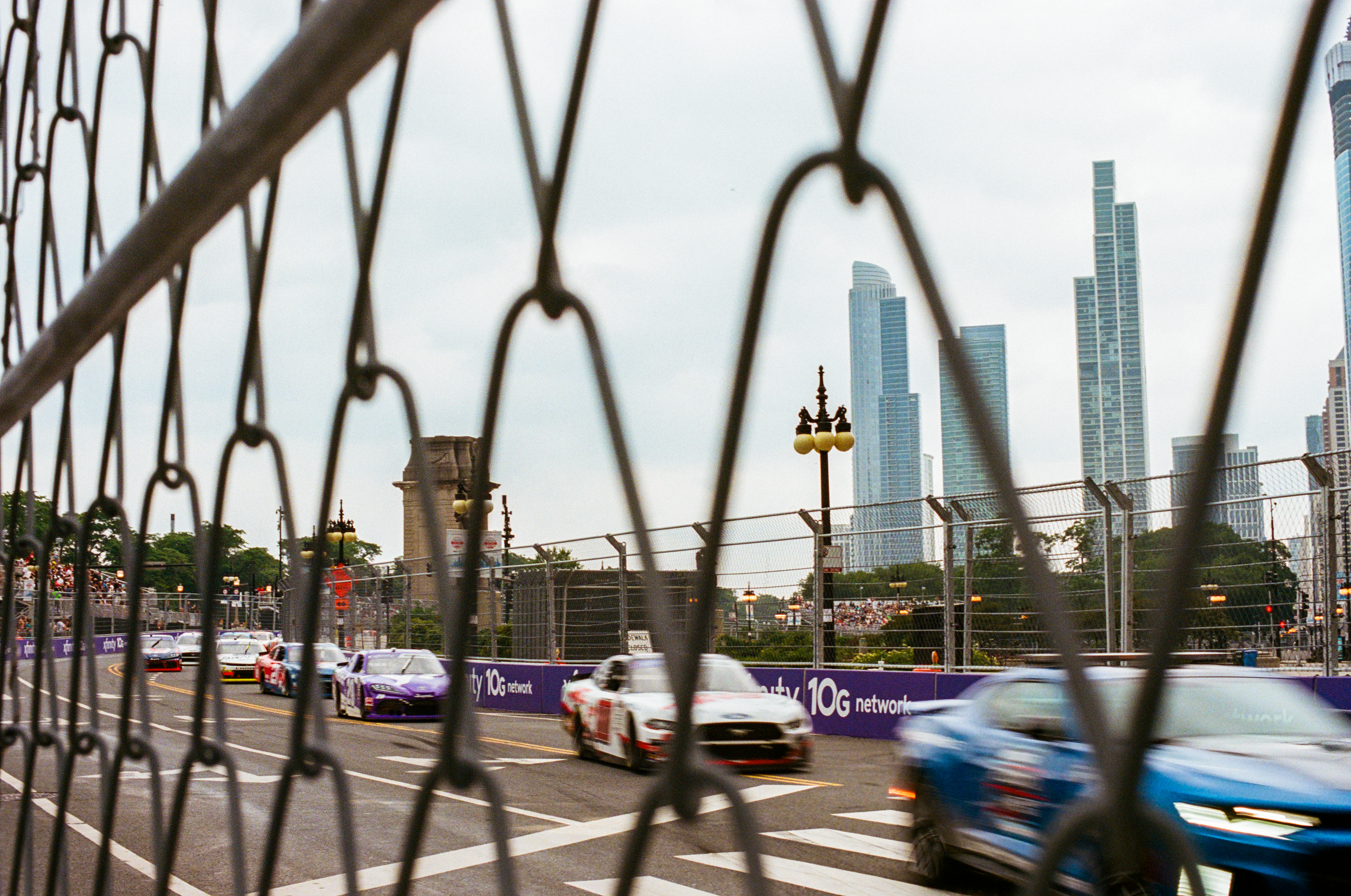
Final laps of the NASCAR Xfinity Series The Loop 121 at the entrance of Turn 10. Photo by Varun Khushalani.
In the photo room, there was a growing sense of hope that this, too, would be delayed or even canceled. Cameras don’t belong in the rain. To bring them into the rain, covers had to be made of plastic for those who didn’t have specially made covers. Drenched photographers came in and out, telling more of the perilous condition and the growing possibility of another race being called off. I listened in fear, praying I had taken enough shots the day before. The race start had already been delayed, and the idea of going back out was not met with enthusiasm. However, the rain suddenly decided to stop, and the room got a lot more active. Then, like clockwork, someone shouted out that the race start was now 5:15, and that drivers were being called to their cars. We all nearly sprinted out of the building.
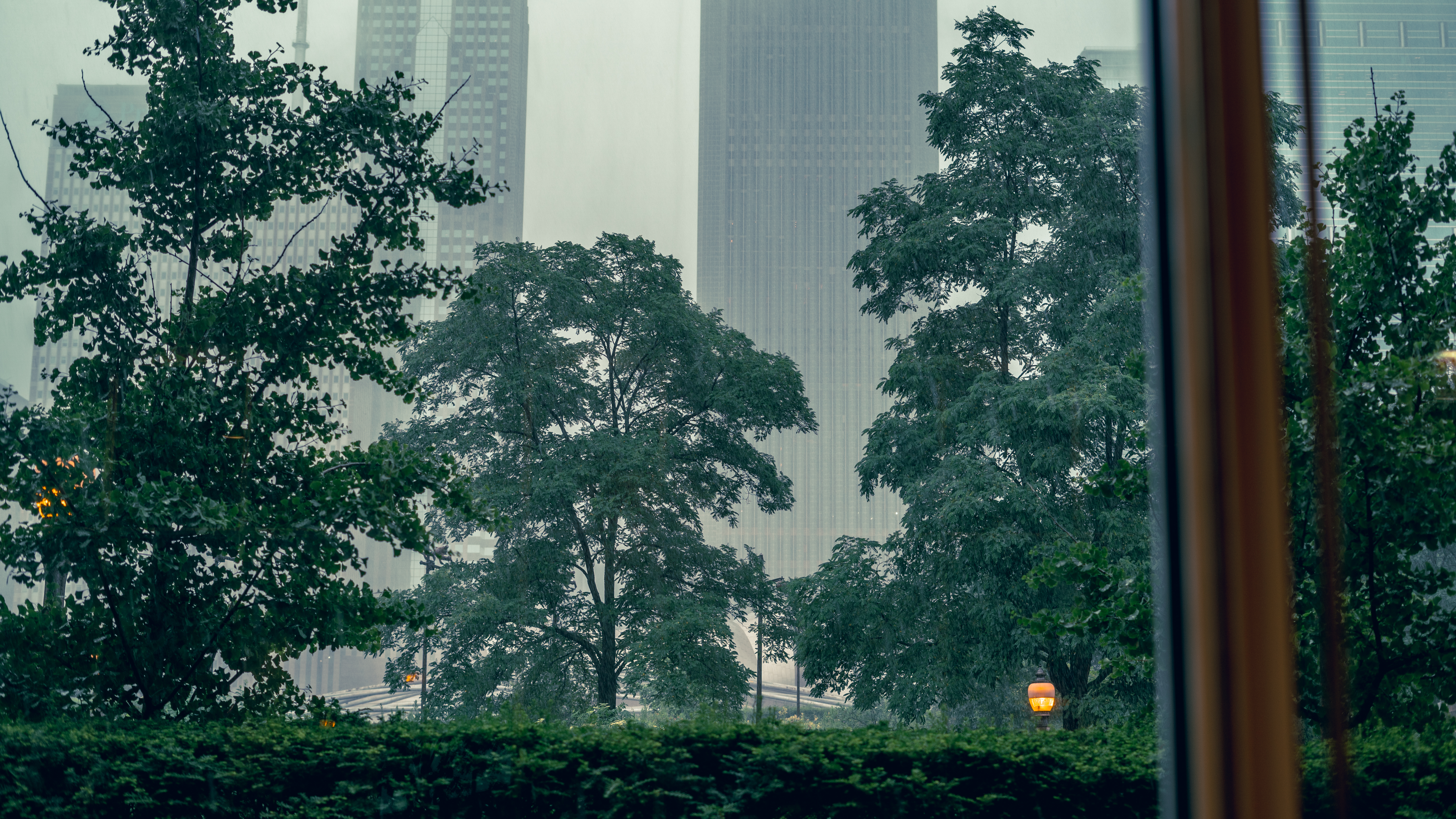
Millennium Park from the photographers room at The Art Institute of Chicago. Photo by Varun Khushalani.
For the start of the race, I went to the Start/Finish line. What I wasn’t expecting to see was the Grandstands and the President’s Paddock Club, the most exclusive VIP section, both fully packed; one full of ponchos, the other under cover. The fans had stuck through it. Everywhere I went, I saw packed crowds leaning over fences and cramming into seats in the stands. This deeper love for the sport and unquestionable admiration for the racers kept them at the track even through treacherous weather. I didn’t even come to the track until about 3 knowing there wouldn’t be racing (and being quite lazy). But, when walking around, I saw fans standing in deep puddles just to get a better view of the track. And I admire them for it.
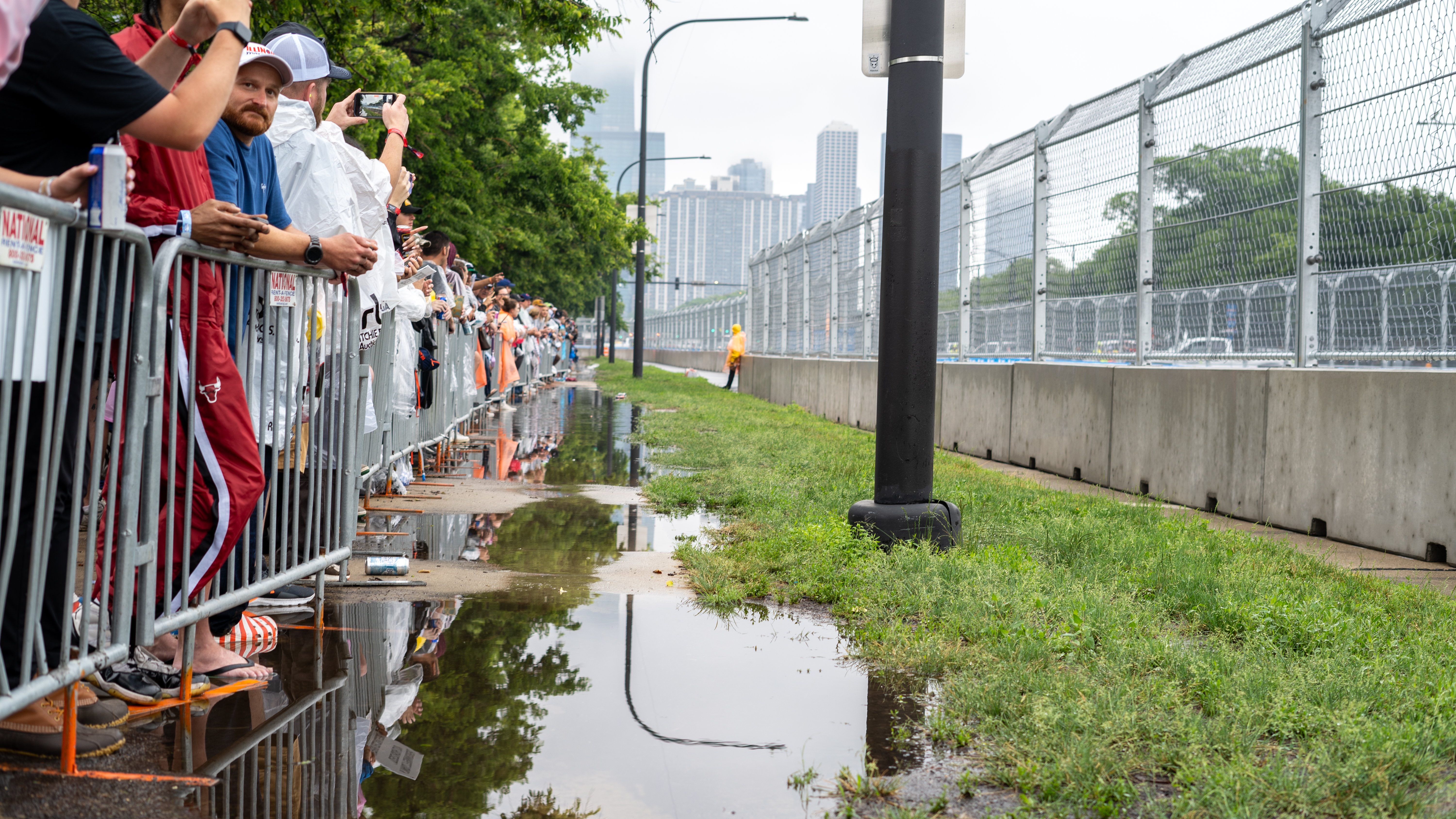
Spectators on South DuSable Lake Shore Drive during the NASCAR Cup Series Grant Park 220. Photo by Varun Khushalani.
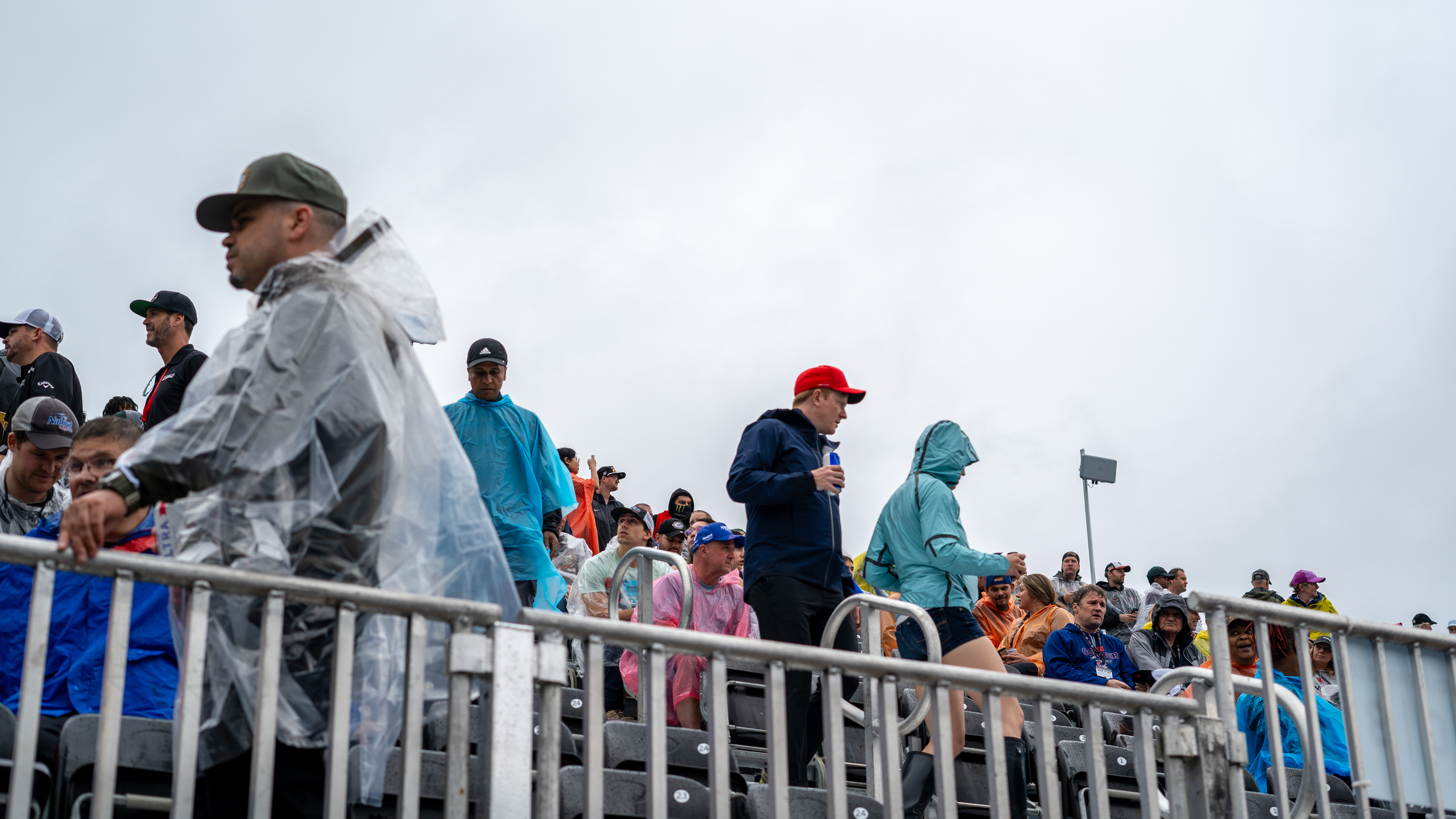
Spectators in the grandstands on South Columbus Drive before the start of the NASCAR Cup Series Grant Park 220. Photo by Varun Khushalani.
Ninety minutes later than scheduled, Denny Hamlin, who had won the Busch Light Pole Award in the No. 11 Yahoo! Toyota, led the pack into Turn 1 (He subsequently lost the lead going into Turn 2). Throughout 75 laps, originally supposed to be 100 but shortened due to the delay, nine cautions were given due to driving incidents, each as brutal as the last. Due to the strange nature of roaming aimlessly around a race track, I only managed to personally witness two of these incidents, the others I had to watch on screens like everyone else. Tire barriers are used to soften the blow in especially problematic corners, such as Turns 1 and 6, both of which I witnessed accidents in. It’s different seeing it happen right in front of you. They just come out of nowhere, so at first, you are always looking in the wrong spot. Then suddenly, a car, which was on a normal racing line, now isn’t and veers directly into a barrier, spraying water everywhere. Even though it seems like it should be safe, there are always reminders of how dangerous this sport can be.

Tyler Reddick, driver of the No. 45 Monster Energy Toyota, being pulled out of the tire barriers at Turn 6 during the NASCAR Cup Series Grant Park 220. Photo by Varun Khushalani.
—
The big question that needs to be answered by NASCAR and the City of Chicago is, naturally, “Should this happen again next year?” Obviously, it’s not an easy answer, but a few things should be mentioned. First, the organizing issues need to be fixed as well. There was no serious harm or injury to fans during the evacuation. But that doesn’t mean it couldn’t happen. Either the City of Chicago or the race organizers overlooked important safety decisions in their construction of the race. They built a beautiful track that exemplified the beauty of Chicago and created excellent entertainment for those watching at home. But next year, they have to build some more bridges.
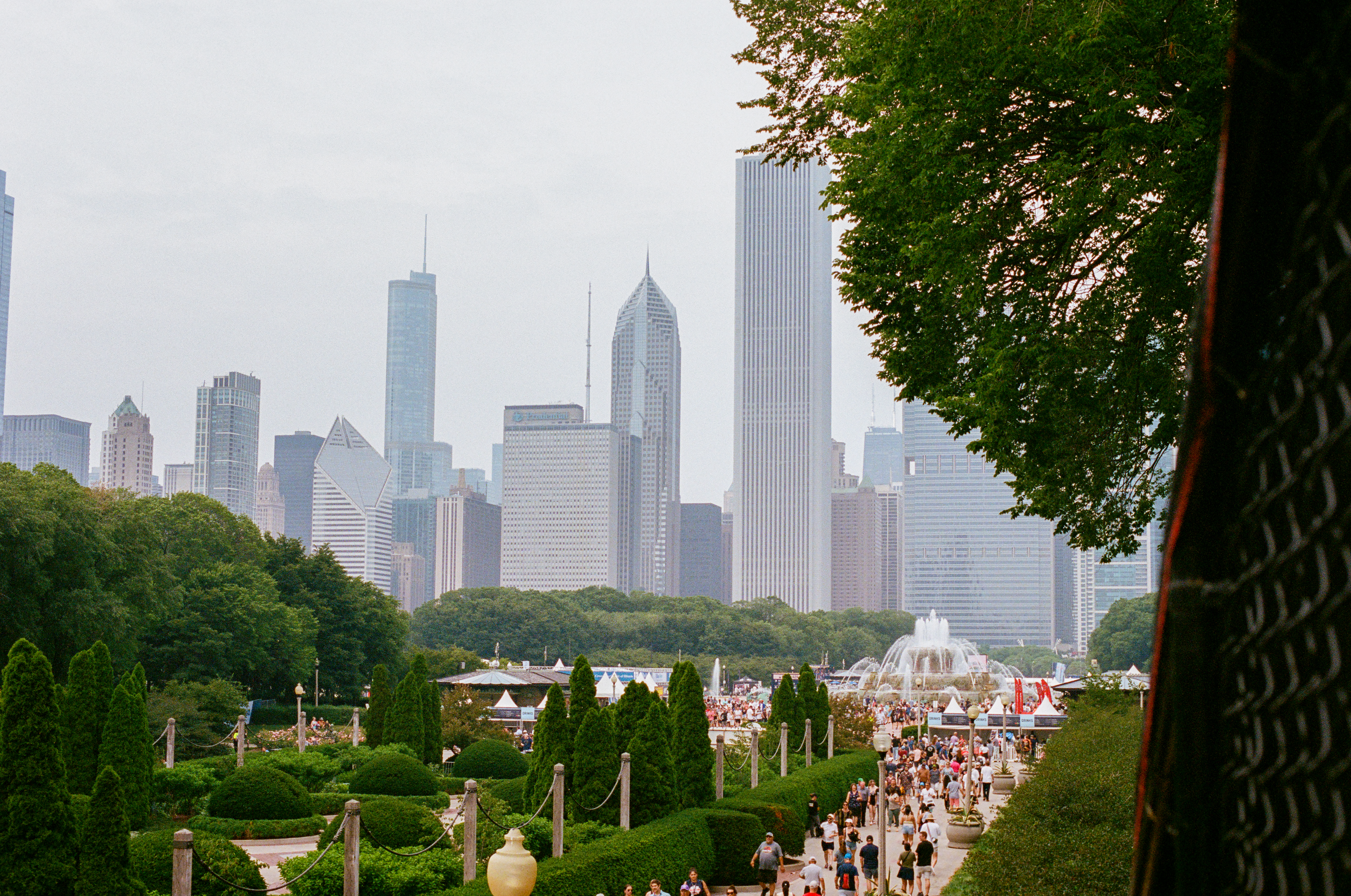
The Fan Plaza at Buckingham Fountain. Photo by Varun Khushalani.
More ideologically, I think there is a fan base to be won here in Chicago, but it isn’t the one NASCAR marketed this race towards. All the advertising, all the attractions, the concerts, they pointed toward a specific demographic which NASCAR performs well with. However, Chicago does not fulfill that demographic. This organization hasn’t necessarily done a good job in the past to combat issues of diversity and injustice. This race aimed to try and breathe new life into the sport. The viewership numbers show that NASCAR has not performed well this past decade, and each new innovation and implemented rule change proves this. New attractions and events are how sports reinvent themselves and how they adapt and grow. The MLB, ATP, even International Cricket are facing the same dilemma: either make the sport more interesting to save the sport, or cater to an older fanbase and protect it’s history. These iconic sports brands have an impossible decision to make in a new age where people from around the world are paying attention. Formula 1 made their decision, and it paid off. Drive to Survive created an entirely new American audience, and while some older fans don’t like what it has done to the sport, the rebrand was a massive success financially.
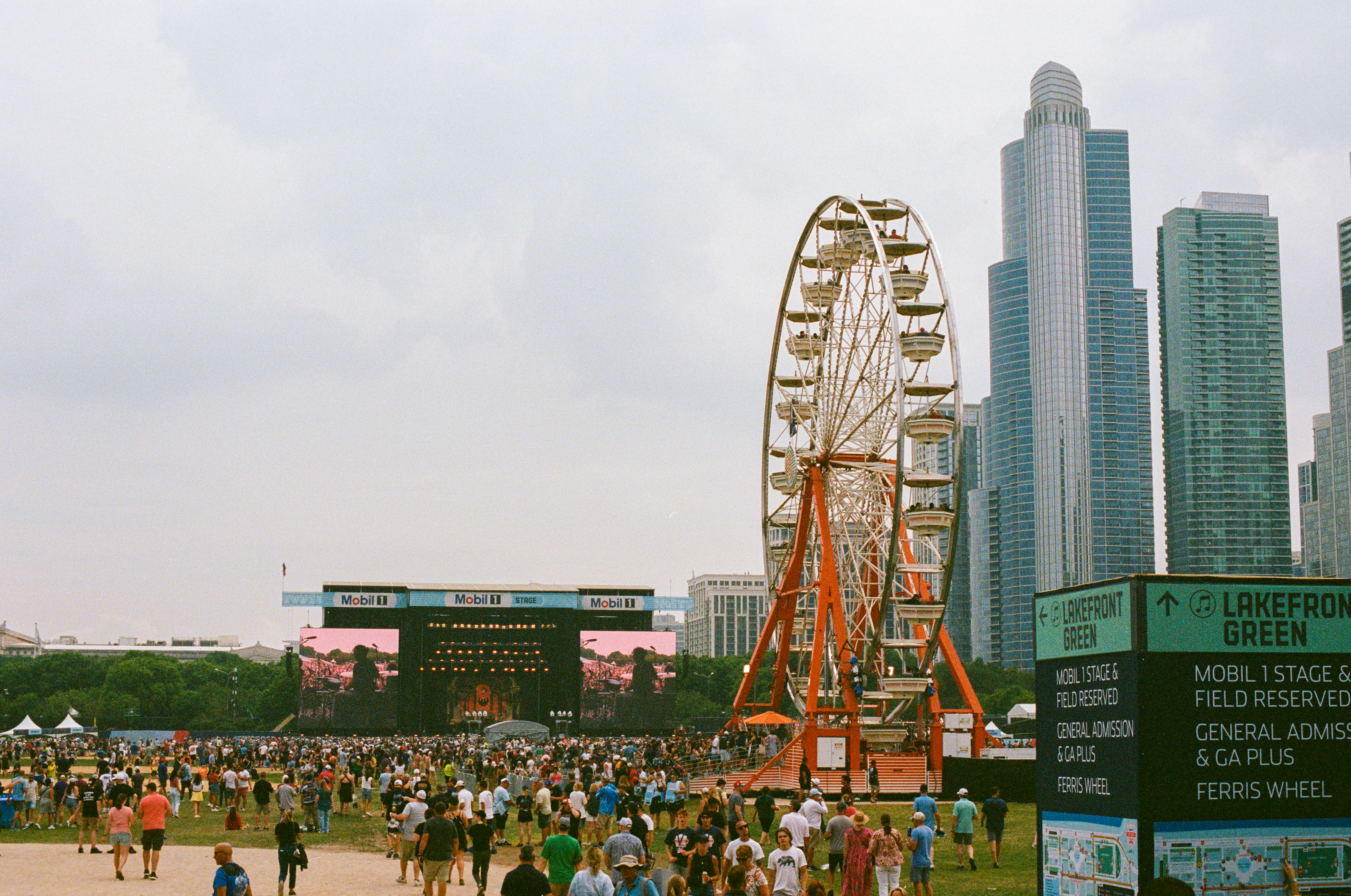
Ferris Wheel and the Mobil 1 Stage on the Lakefront Green. Photo by Varun Khushalani.
I’m not a NASCAR fan, and to be honest, this event didn’t make me one. They put on a fantastic race, one I’ll never forget, but the event itself left some things to be desired. And I knew if I tuned in to watch the next race, I’d get more of the same that turned me away before. This sport, undoubtedly, has a deep and long history. But history isn’t the aspect of sport that should be honored. It’s time they really start thinking about the future and opening the sport to those who want it, just not in its current form.

Spectators on East Balbo Drive watching the NASCAR Cup Series Grant Park 220. Photo by Varun Khushalani.
—
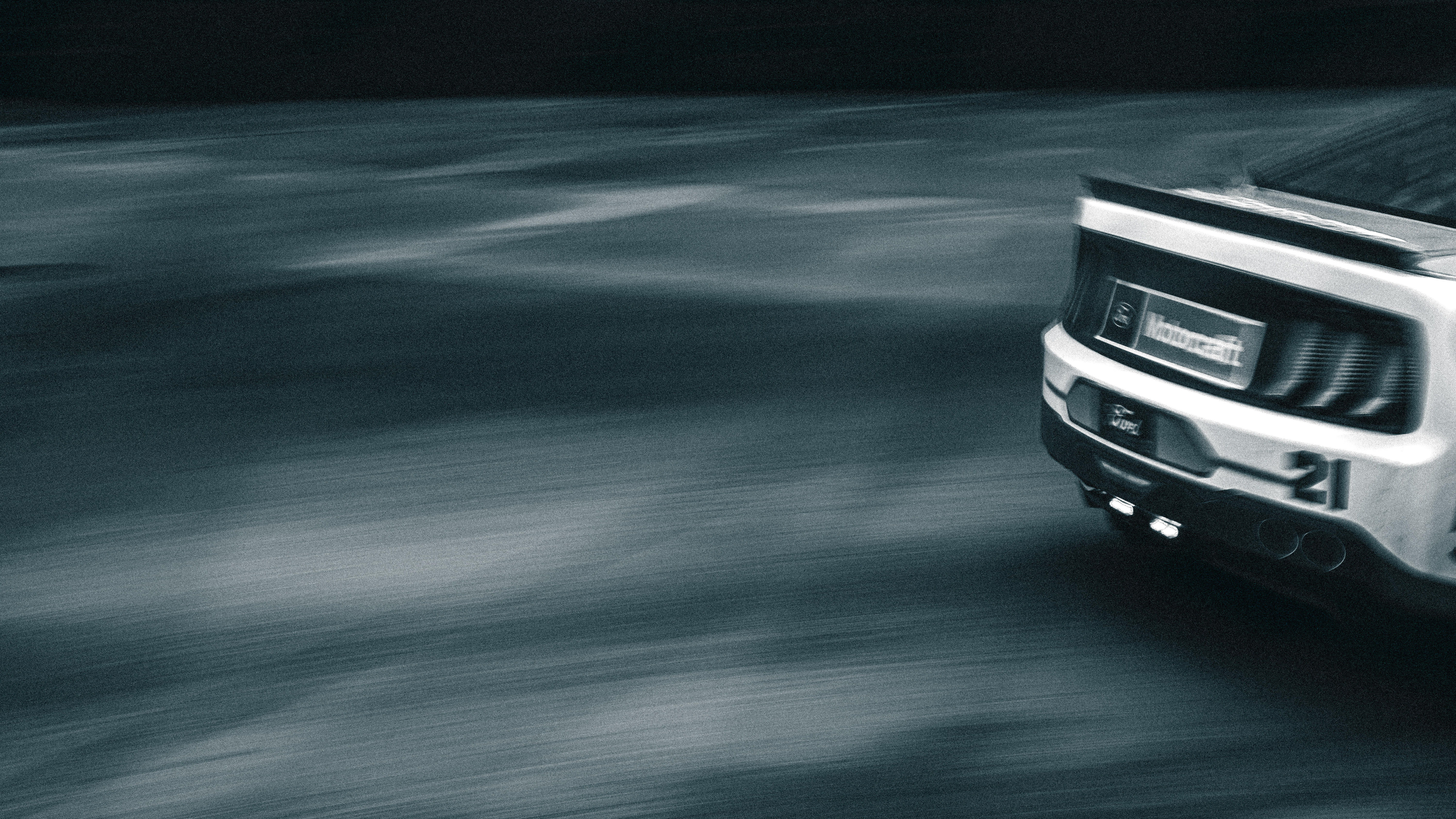
Harrison Burton, driver of the No. 21 Motorcraft/Quick Lane Ford, at the exit of Turn 5. Photo by Varun Khushalani.
It wasn’t an easy weekend by any means. It’s quite lonely out there, and both days were spent roaming around the track, waiting for a car to come or a caution to cease. However, being there gave me a new appreciation for NASCAR, as well as Chicago itself. Standing right next to the cars, seeing them slide around after coming out of a corner or diving down the inside at high speeds, it gives a new perspective to motorsport. And for Chicago, to have the trust in an organization to shut off traffic, ship in thousands of concrete barriers, to deliberately slow down the pace of the city on July 4th weekend took a courage I’m not used to nowadays. At the end of the day, they took a risk, and in my opinion, it paid off. Even though a historic spell of air pollution, followed by a historic spell of rain, the partnership created a spectacle worth staying and watching. So I think next year, if done well, the event could be an even greater success. Racing through Chicago in 2023 will be a memory that NASCAR and its fans will return to for years. Now, we just have to see if they can make it stick.
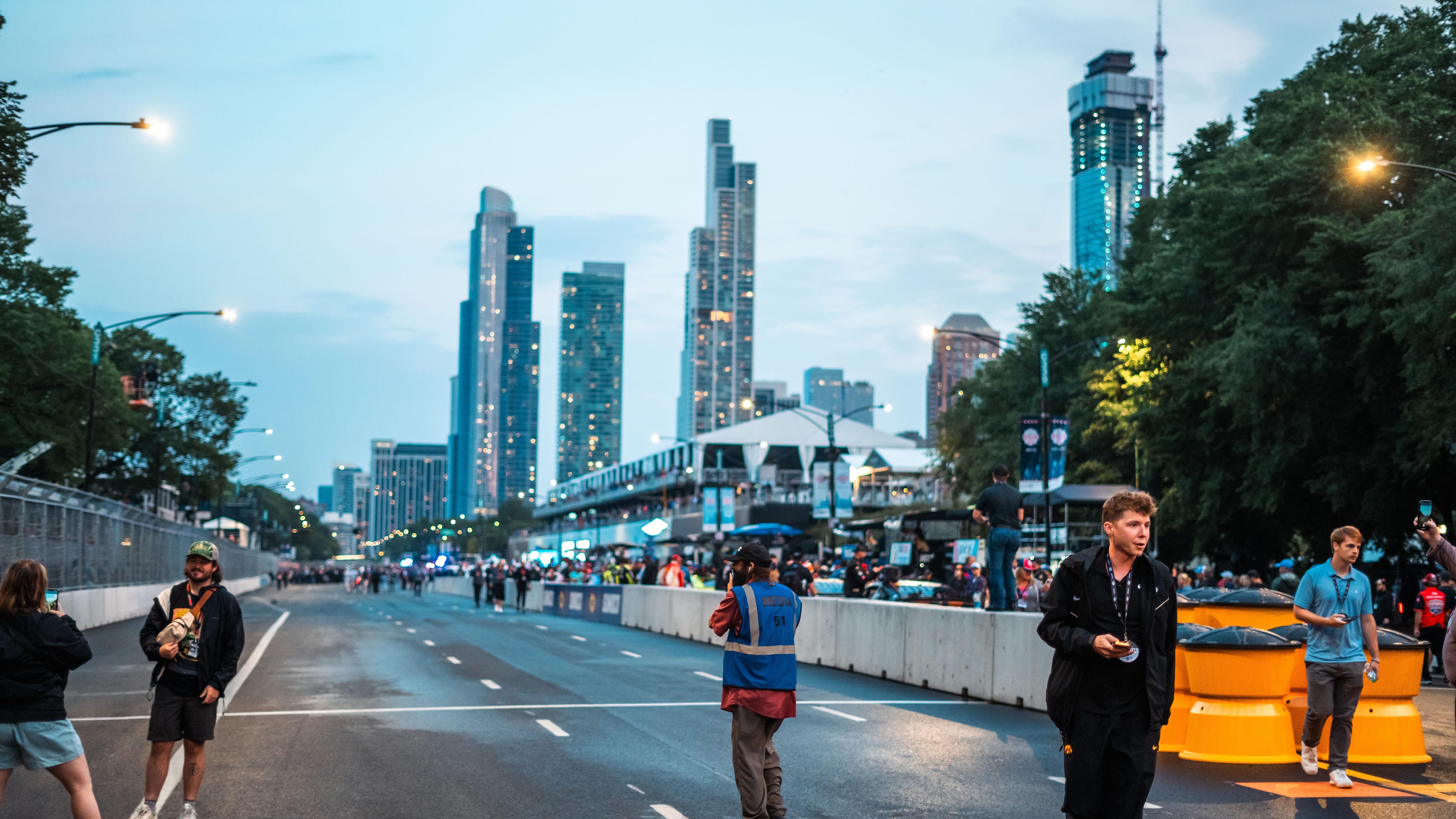
Celebrations on pit road after the end of the NASCAR Cup Series Grant Park 220. Photo by Varun Khushalani.
—
As the weather cleared, and a beautiful sunset greeted the end of the race, it was New Zealander Shane van Gisbergen, in the No. 91 Enhance Health Chevrolet, who took the checkered flag after a tense fight with Justin Haley in the No. 31 Benesh Law Chevrolet went into overtime after late-race cautions. During the last few laps, as the sky got darker and it became harder to photograph, I began just watching the cars. Watching them flow and react, the natural rhythm of the racing. I had gotten enough photos, and the part of me which wanted to photograph this race in the first place was rewarded with the image I had dreamed of — race cars sprinting up Wells Avenue as the sun began to set, ducking and weaving in front of a gorgeous skyline.
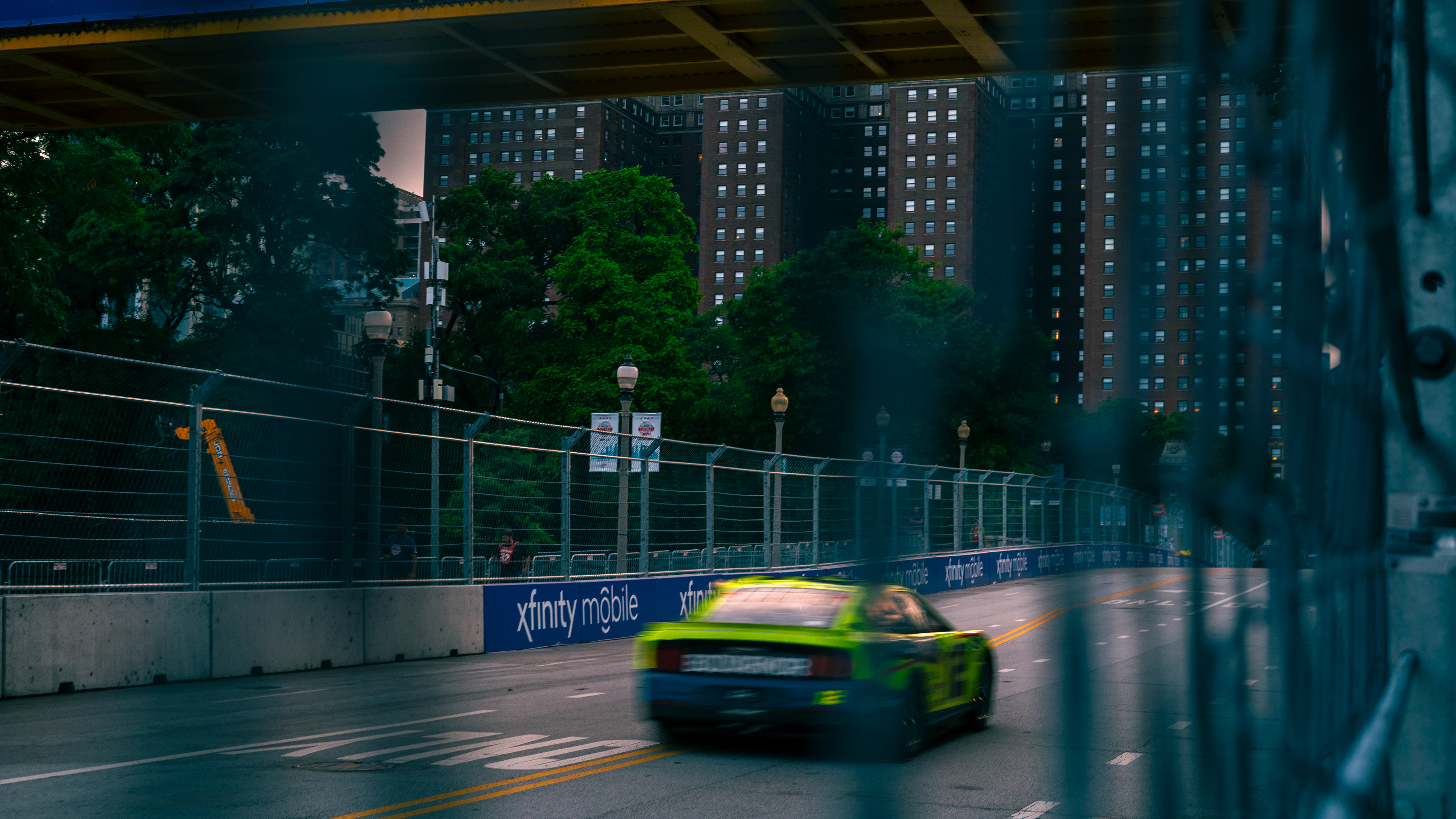
Photo by Varun Khushalani.
Header image by Varun Khushalani.


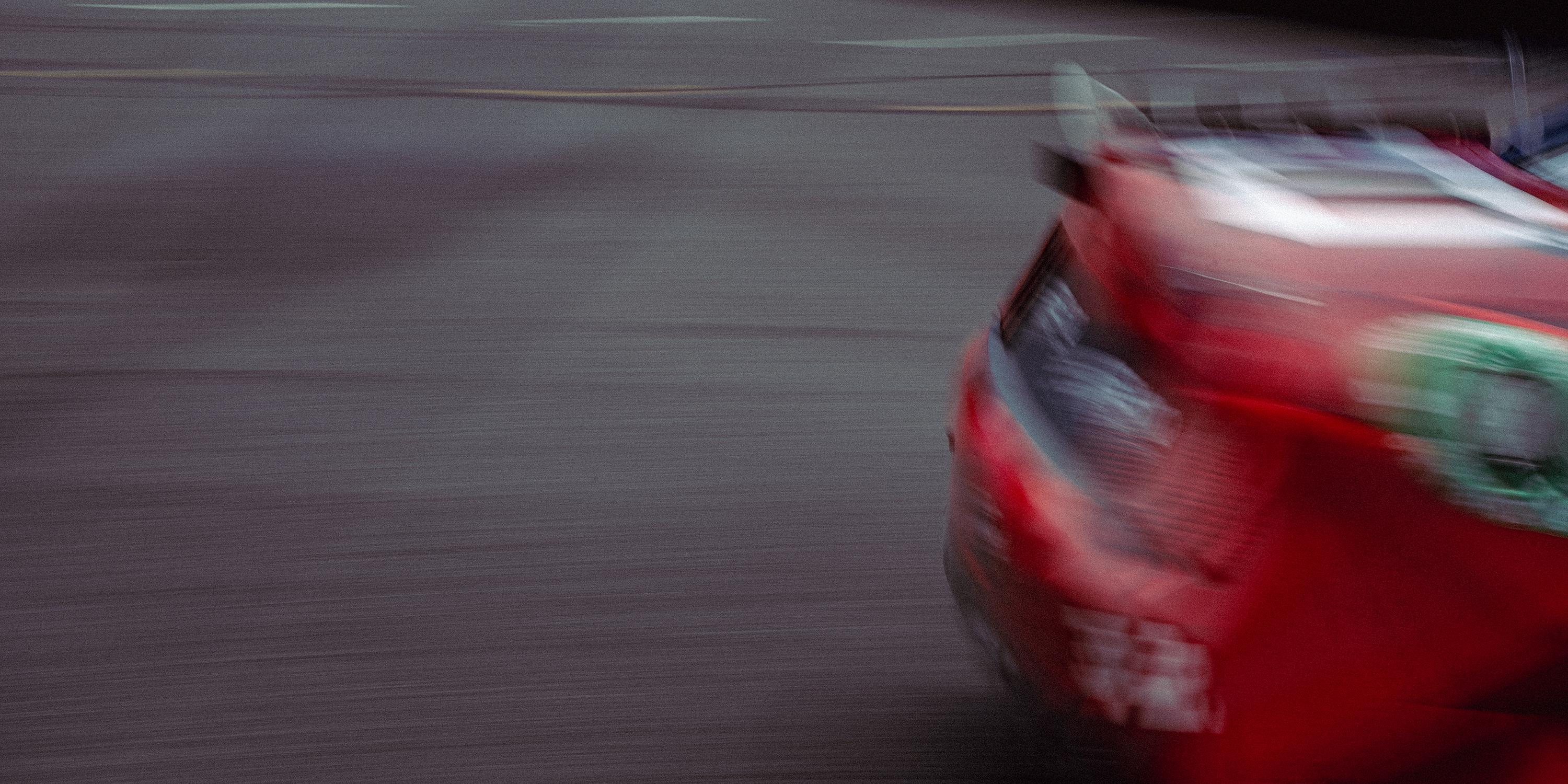

NO COMMENT